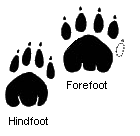Spoor (animal)
Spoor refers to any sign of a creature or trace by which the progress of someone or something can be followed. A spoor can include tracks, scents, droppings, or any other physical evidence of an animal passing through an area. Tracking spoor is a fundamental skill in hunting, wildlife research, and outdoor survival practices. It is also crucial in the study of animal behavior and ecology, providing insights into the habits and habitats of various species.
Types of Spoor[edit | edit source]
Spoor can be categorized into several types, each offering different kinds of information about the animals that left them:
- Tracks: Perhaps the most recognized form of spoor, tracks are the footprints or hoofprints left by animals. Analyzing the size, shape, and pattern of tracks can reveal the species, the direction of travel, and sometimes the speed and behavior of the animal at the time.
- Droppings: Also known as scat, droppings can help identify an animal's presence and diet. The size, shape, and content of droppings can indicate the species and provide clues about the local flora and fauna.
- Urine: The scent of urine is another way to track animals, especially for predators or during mating seasons. The chemical composition of urine can signal an animal's territory, reproductive status, and health.
- Feathers, fur, and scales: These can indicate the presence of specific birds, mammals, or reptiles, respectively. They can also provide information about molting or shedding patterns, health, and species identification.
- Rubbings and scratchings: Marks on trees or the ground made by animals as they rub or scratch themselves can indicate territory boundaries, the presence of parasites, or communication between individuals of the same species.
Tracking and Interpretation[edit | edit source]
The art of tracking involves more than just recognizing spoor; it requires interpreting the signs to understand the behavior and movement of animals. Trackers look at the age of the spoor, considering factors like weather and substrate condition, to determine how recently an animal passed through. They also analyze patterns and disturbances in the environment to reconstruct an animal's path and activities.
Applications of Spoor Tracking[edit | edit source]
- Wildlife management and conservation: Understanding animal movements and behavior is crucial for creating effective conservation strategies. Spoor tracking allows researchers to monitor species without direct observation, which can be less intrusive and stressful for animals.
- Hunting: Hunters have used spoor tracking for centuries to locate prey. Knowledge of spoor can lead hunters to animal habitats and watering holes.
- Search and rescue operations: In some cases, tracking skills can be applied to find lost persons by identifying and following their spoor.
- Ecotourism and outdoor education: Spoor tracking is also an educational tool, teaching people about wildlife and the importance of conservation.
Challenges in Spoor Tracking[edit | edit source]
Despite its applications, spoor tracking faces challenges, including:
- The difficulty of tracking in varying environmental conditions, such as after rain or in dense vegetation.
- The need for extensive knowledge and experience to accurately identify and interpret spoor.
- The potential for disturbance of natural habitats and animal behaviors by humans following spoor.
Conclusion[edit | edit source]
Spoor tracking remains a vital skill in understanding and interacting with the natural world. It bridges traditional knowledge with modern conservation efforts, providing a non-invasive method to study and appreciate wildlife.
Search WikiMD
Ad.Tired of being Overweight? Try W8MD's physician weight loss program.
Semaglutide (Ozempic / Wegovy and Tirzepatide (Mounjaro / Zepbound) available.
Advertise on WikiMD
|
WikiMD's Wellness Encyclopedia |
| Let Food Be Thy Medicine Medicine Thy Food - Hippocrates |
Translate this page: - East Asian
中文,
日本,
한국어,
South Asian
हिन्दी,
தமிழ்,
తెలుగు,
Urdu,
ಕನ್ನಡ,
Southeast Asian
Indonesian,
Vietnamese,
Thai,
မြန်မာဘာသာ,
বাংলা
European
español,
Deutsch,
français,
Greek,
português do Brasil,
polski,
română,
русский,
Nederlands,
norsk,
svenska,
suomi,
Italian
Middle Eastern & African
عربى,
Turkish,
Persian,
Hebrew,
Afrikaans,
isiZulu,
Kiswahili,
Other
Bulgarian,
Hungarian,
Czech,
Swedish,
മലയാളം,
मराठी,
ਪੰਜਾਬੀ,
ગુજરાતી,
Portuguese,
Ukrainian
Medical Disclaimer: WikiMD is not a substitute for professional medical advice. The information on WikiMD is provided as an information resource only, may be incorrect, outdated or misleading, and is not to be used or relied on for any diagnostic or treatment purposes. Please consult your health care provider before making any healthcare decisions or for guidance about a specific medical condition. WikiMD expressly disclaims responsibility, and shall have no liability, for any damages, loss, injury, or liability whatsoever suffered as a result of your reliance on the information contained in this site. By visiting this site you agree to the foregoing terms and conditions, which may from time to time be changed or supplemented by WikiMD. If you do not agree to the foregoing terms and conditions, you should not enter or use this site. See full disclaimer.
Credits:Most images are courtesy of Wikimedia commons, and templates Wikipedia, licensed under CC BY SA or similar.
Contributors: Prab R. Tumpati, MD

